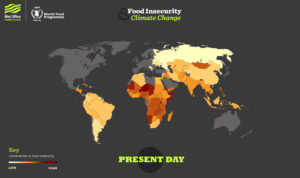As communities around the globe, especially those in poorer regions, are suffering increasingly from the negative impacts of climate change, the importance of climate adaptation is becoming more apparent. As described by the United Nations, adaptation involves reducing the risks faced by both humans and natural systems.
It helps to ensure that we can cope with the effects of climate change. Building sea walls to protect coastal communities from rising sea levels is one example of adaptation; developing drought and heat-resistant crops is another.
Adaptation is most commonly associated with applications such as these, so it might be surprising to learn that adaptation could also play a role in reducing the risk of violent conflict.
Climate change-related conflict has attracted increasing amounts of attention, with political figures such as Barack Obama making statements about the world becoming hungrier and more violent as a result of global warming. There are a number of examples that illustrate this; perhaps the most famous is the claim that the civil war in Syria was in part driven by a drought that ravaged the country in the preceding years.
Other examples include the possibility that the growth of Islamist militant group Boko Haram has been fueled by the Lake Chad humanitarian crisis, as well as the deadly conflict between cattle herders and farmers throughout parts of East Africa. In both instances, changing rainfall and rising temperatures have been suggested as possible catalysts.
However, there are complex issues involved in determining if climate change is making conflict more likely. In the scientific literature, there are no agreed-upon direct links between climate change and conflict. Rather, there are a number of socio-political and economic issues that mediate the direct impacts of climate change, making any link(s) indirect and dependent on these pre-existing issues. Usually, the affected communities live below the poverty line, have little or no access to information and technology, are isolated and sometime politically or religiously marginalized – hence their increased level of vulnerability to climate-related conflict risks.
This is where climate adaptation comes in. These vulnerable communities are the most in need of adaptation initiatives, especially where there is the potential for a conflict mitigation dividend.
A case study in Rwanda showed how climate adaptation has helped to rehabilitate agricultural land, sustain vulnerable livelihoods and ultimately assist in reducing the stress on resources experienced by these communities. It is through reducing this resource stress that, the author argues, adaptation could contribute to peace and perhaps reduce the risk of conflict.
A paper recently published in the journal Sustainable Earth outlines more specific guidelines for how adaptation can reduce the conflict risk associated with climate change and how ongoing research should proceed. The paper suggests developing a vulnerability model, which would highlight how to assess where and when conflict risk will increase. The model also highlights how adaptation can reduce this conflict risk.
But it is important to keep in mind that because there is no simple or direct connection between climate change and conflict, climate adaptation should not focus only on the direct impacts of climate change, such as increasing temperatures. Additionally, this model and its suggested variables – along with its implication – still need rigorous empirical testing.
Nonetheless, this approach represents a new and useful source of potential. Developing ways of reliably forecasting the risk of future conflict, and hence where adaptation is most needed, can help communities better prepare and build resilience. Vulnerable communities that are prepared in the face of disasters and climate stress have better survival rates than those that are not. A recent Agenda blog post highlighted the important role that data plays in helping regions manage risk and cope with natural disasters.
Climate adaptation’s value to vulnerable communities has been documented by the Intergovernmental Panel on Climate Change for decades. Adaptation is also an integral part of the UN’s Sustainable Development Goal 13.
Without adaptation [note from Storm Cunningham: such as via regenerative agriculture, which also helps restore the climate by sequestering vast amounts of carbon], vulnerable communities can be expected to continue to suffer the harmful impacts of climate change, including mass migration (both internally and externally) and a potentially higher risk of conflict – and their sustainable and carbon-free futures will be increasingly difficult to achieve.
Featured (by REUTERS/Afolabi Sotunde) shows women and children rescued from Boko Haram. Has climate change played a part in the group’s growth?
This article by Daniel Pearson (Graduate of the Curtin University Sustainability Policy Institute, CUSP) originally appeared on the World Economic Forum website.
Reprinted here (with minor edits) by permission.


